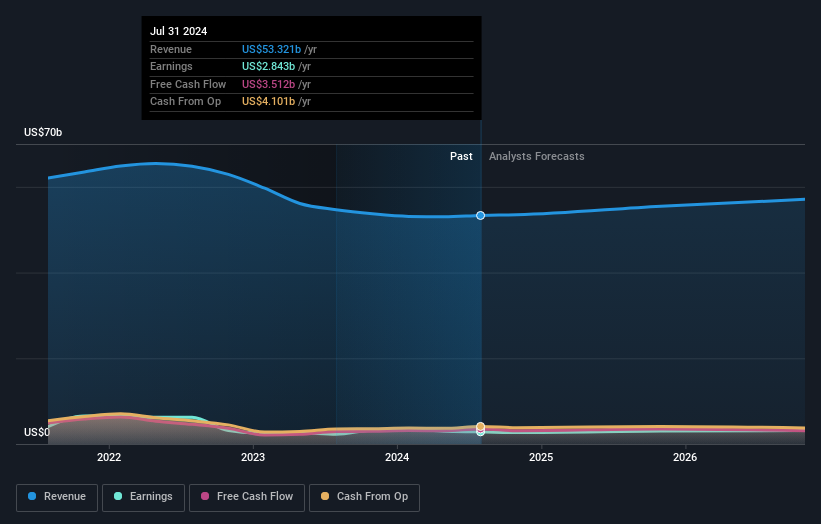- United States
- /
- Tech Hardware
- /
- NYSE:HPQ
HP Inc. Just Missed Earnings - But Analysts Have Updated Their Models

Last week saw the newest third-quarter earnings release from HP Inc. (NYSE:HPQ), an important milestone in the company's journey to build a stronger business. Revenues were in line with forecasts, at US$14b, although statutory earnings per share came in 15% below what the analysts expected, at US$0.65 per share. Earnings are an important time for investors, as they can track a company's performance, look at what the analysts are forecasting for next year, and see if there's been a change in sentiment towards the company. So we collected the latest post-earnings statutory consensus estimates to see what could be in store for next year.
View our latest analysis for HP

Taking into account the latest results, the consensus forecast from HP's 14 analysts is for revenues of US$55.5b in 2025. This reflects a satisfactory 4.1% improvement in revenue compared to the last 12 months. Statutory earnings per share are predicted to increase 9.4% to US$3.18. Before this earnings report, the analysts had been forecasting revenues of US$55.8b and earnings per share (EPS) of US$3.27 in 2025. The analysts seem to have become a little more negative on the business after the latest results, given the minor downgrade to their earnings per share numbers for next year.
The consensus price target held steady at US$36.04, with the analysts seemingly voting that their lower forecast earnings are not expected to lead to a lower stock price in the foreseeable future. There's another way to think about price targets though, and that's to look at the range of price targets put forward by analysts, because a wide range of estimates could suggest a diverse view on possible outcomes for the business. The most optimistic HP analyst has a price target of US$42.00 per share, while the most pessimistic values it at US$30.00. As you can see, analysts are not all in agreement on the stock's future, but the range of estimates is still reasonably narrow, which could suggest that the outcome is not totally unpredictable.
Looking at the bigger picture now, one of the ways we can make sense of these forecasts is to see how they measure up against both past performance and industry growth estimates. One thing stands out from these estimates, which is that HP is forecast to grow faster in the future than it has in the past, with revenues expected to display 3.2% annualised growth until the end of 2025. If achieved, this would be a much better result than the 1.5% annual decline over the past five years. Compare this against analyst estimates for the broader industry, which suggest that (in aggregate) industry revenues are expected to grow 7.7% annually for the foreseeable future. So although HP's revenue growth is expected to improve, it is still expected to grow slower than the industry.
The Bottom Line
The biggest concern is that the analysts reduced their earnings per share estimates, suggesting business headwinds could lay ahead for HP. On the plus side, there were no major changes to revenue estimates; although forecasts imply they will perform worse than the wider industry. There was no real change to the consensus price target, suggesting that the intrinsic value of the business has not undergone any major changes with the latest estimates.
With that said, the long-term trajectory of the company's earnings is a lot more important than next year. We have forecasts for HP going out to 2026, and you can see them free on our platform here.
Plus, you should also learn about the 3 warning signs we've spotted with HP (including 1 which is a bit concerning) .
Valuation is complex, but we're here to simplify it.
Discover if HP might be undervalued or overvalued with our detailed analysis, featuring fair value estimates, potential risks, dividends, insider trades, and its financial condition.
Access Free AnalysisHave feedback on this article? Concerned about the content? Get in touch with us directly. Alternatively, email editorial-team (at) simplywallst.com.
This article by Simply Wall St is general in nature. We provide commentary based on historical data and analyst forecasts only using an unbiased methodology and our articles are not intended to be financial advice. It does not constitute a recommendation to buy or sell any stock, and does not take account of your objectives, or your financial situation. We aim to bring you long-term focused analysis driven by fundamental data. Note that our analysis may not factor in the latest price-sensitive company announcements or qualitative material. Simply Wall St has no position in any stocks mentioned.
About NYSE:HPQ
HP
Provides personal computing, printing, 3D printing, hybrid work, gaming, and other related technologies in the United States and internationally.
Undervalued established dividend payer.
Similar Companies
Market Insights
Community Narratives




